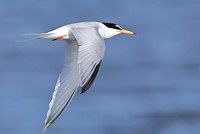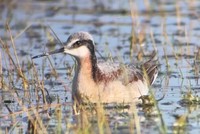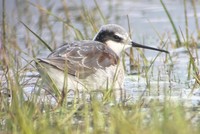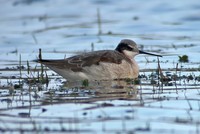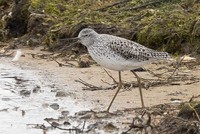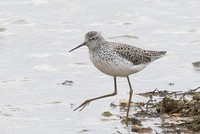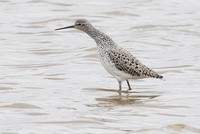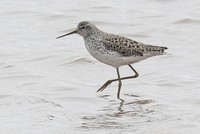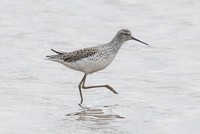Weekly birding round-up: 21 Dec 2016 - 3 Jan 2017
The beginning of the Christmas period saw a sudden shift away from calm, anticyclonic conditions to a more traditional mix of wet and windy westerly weather. Storm ‘Barbara’ brought very strong winds, especially to northern Scotland, on 23rd, followed quickly by even more severe conditions from Storm ‘Conor’ over the Christmas period itself. With winds reaching over 90 mph, this was a grim Christmas indeed in the Northern Isles and the far north. ‘Conor’ also brought snow to parts of mainland Scotland. Further south it was briefly very mild but then abruptly colder again from Boxing Day with a return to cold, calm, anticyclonic weather and widespread frost and fog, particularly in southern and eastern England. On New Year’s Eve temperatures briefly recovered although another plunge of Arctic air behind a cold front on New Year’s Day dropped the temperature once more across most of northern and central England.
Continuing the now familiar theme of autumn 2016, new rare birds were found right to the year’s end whilst the steadily accumulating list of long-staying major rarities was exceptional for mid-winter, perhaps the best ever. With birds from North America, the High Arctic and most parts of Asia all taking up winter residence on our shores, this was a perfect reminder of Britain’s pre-eminent position as the world’s vagrant trap, the end point of some remarkable journeys. Indeed 2016 was one of the best ever years for rarities in Britain, the highlight being an outstanding October for eastern passerines - a period which will surely become the stuff of legend in the years to come.
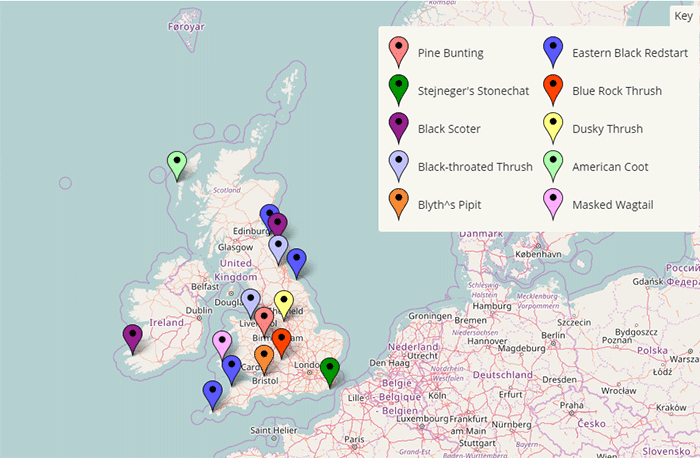
The headline discovery of the Christmas period was an adult male Blue Rock Thrush identified at Stow-on-the-Wold, Gloucestershire on 27th (although it had apparently already been present for at least a week). It then showed well around the houses in a small residential area and was still present to 3rd.
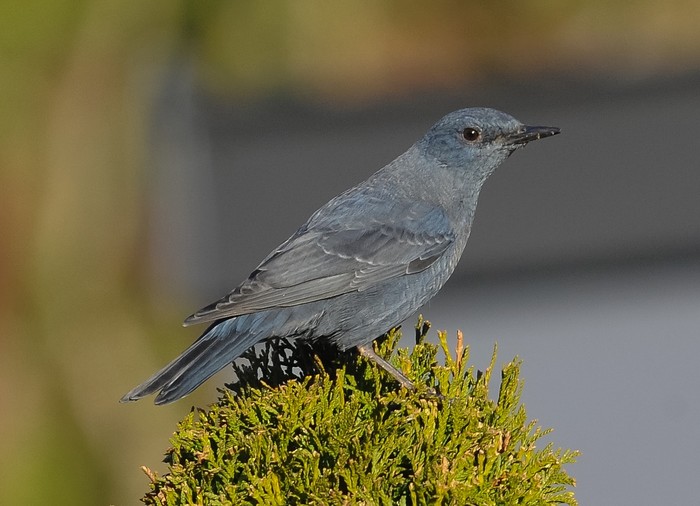
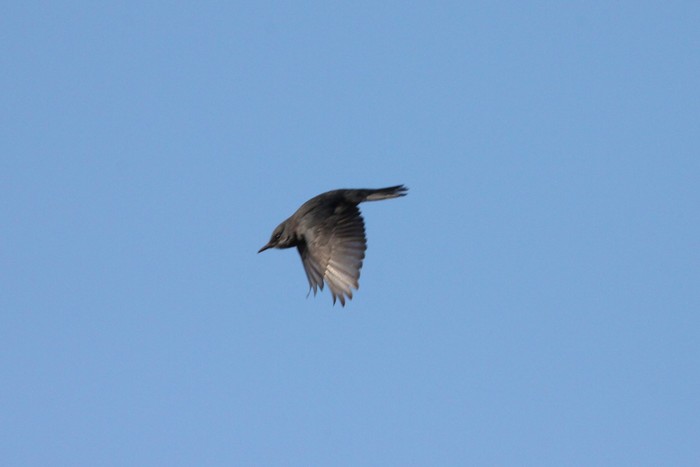
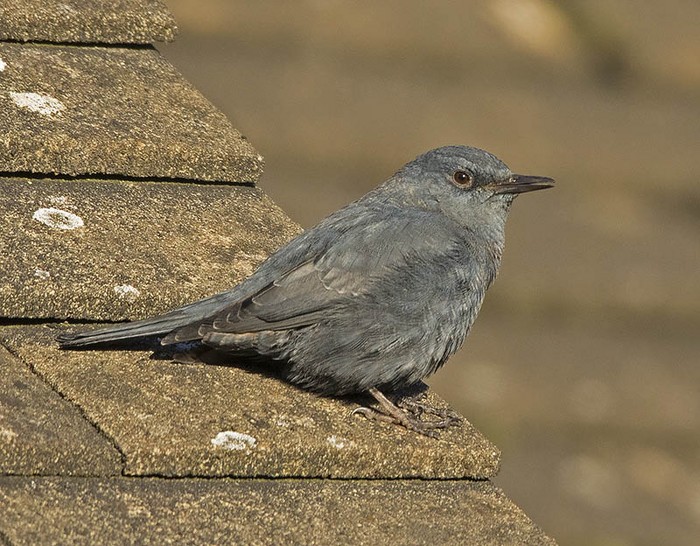
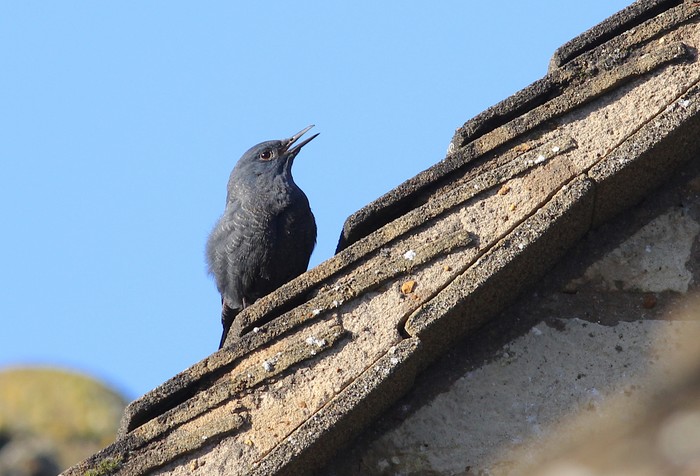
Blue Rock Thrushes (at least of the Mediterranean and Middle East populations) are not long distance migrants but the species has, perhaps surprisingly, managed to reach Britain on five or six previous occasions. The first was at Skerryvore Lighthouse, Argyll in June 1985 with subsequent birds at Moel-y-Gest, Gwynedd in June 1987, St. Mary’s, Isles of Scilly and Cot Valley, Cornwall in October 1999 (the same bird?), Pendeen, Cornwall in May 2000 and Elan Valley, Powys in April 2007.
Please note: subscriber only features and links have been disabled in this graphic.
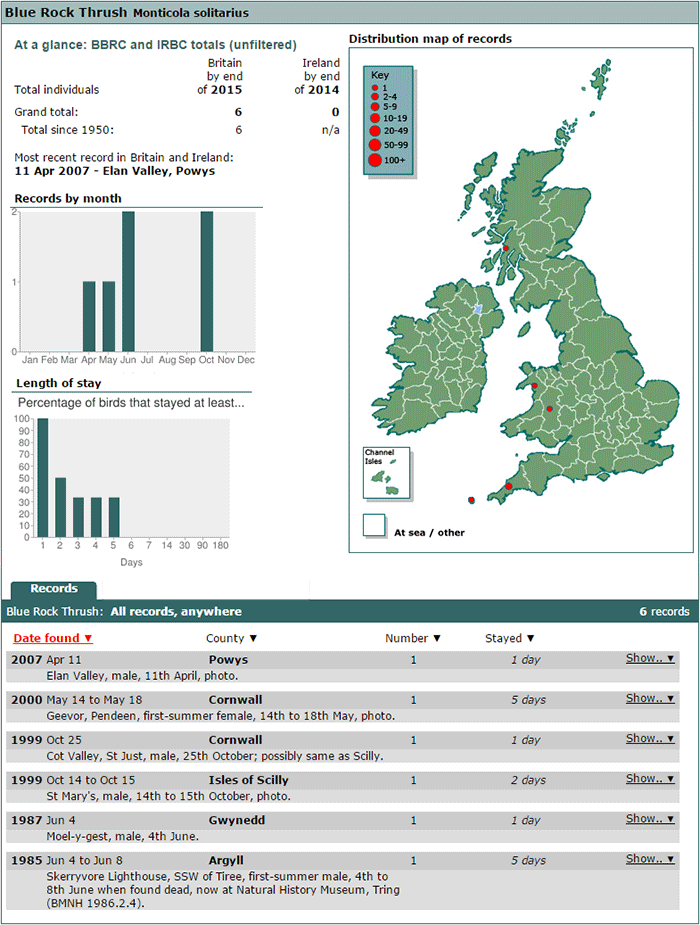
However, the species is also known to be present in the cagebird trade so the origin of the Gloucestershire bird is clearly open to question. Its mid-winter date is certainly surprising, not matching the current pattern of extralimital occurrences either in Britain or elsewhere in northern Europe. Winter records in Britain of Siberian and Mongolian passerines are not unusual (as clearly evidenced this winter) but Blue Rock Thrush has a very different distribution, with the western Mediterranean the most obvious source area for our vagrants. Some might also question the bird’s choice of habitat. All the previous British occurrences have been at classic migrant locations or in suitable montane and rocky settings. None have favoured a suburban environment although such habitats can be occupied in the normal winter range (especially wherever Blackbirds are absent according to BWP). The bird’s age (an adult) might not count significantly against its credentials but it is not the norm in vagrant passerines. The bird’s relative approachability has also been mentioned, potentially significant in what is normally quite a shy species. Nevertheless, given the absence of rings or obvious feather or bare part damage (bar a slightly droopy wing), it will probably be given the benefit of the doubt by some.
Also found during the period (and the last big find of 2016) was a drake Black Scoter with Common Scoters off Goswick, Northumberland on 29th to 3rd. This is the fourteenth Black Scoter for Britain. It is not, however, a new bird for Northumberland or even for Goswick, with previous records at Stag Rocks, Bamburgh on 14th to 20th April 2011, and (presumably the same bird) off Goswick on 11th October to 7th November the same year and then another (also an adult drake) at Cheswick Sands and nearby areas on 20th January to 26th March 2015. As is so often the case with scoters, therefore, this week’s bird could be a returner. Over in Ireland, a drake was again at Rossbeigh, Kerry on 3rd.
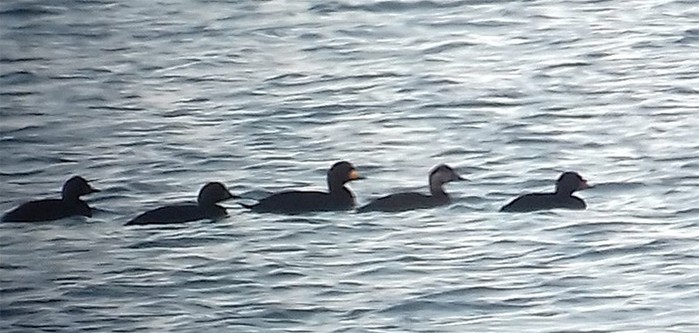
Another top class festive find (and the first new rarity of 2017) was a female Pine Bunting with a large flock of Yellowhammers, Reed Buntings and finches at Venus Pool, near Shrewsbury, Shropshire on 1st and still present, albeit elusive, to 3rd. Although hardly a surprising discovery after the excesses of last autumn, this is still an outstanding record and, inevitably, a new bird for Shropshire.
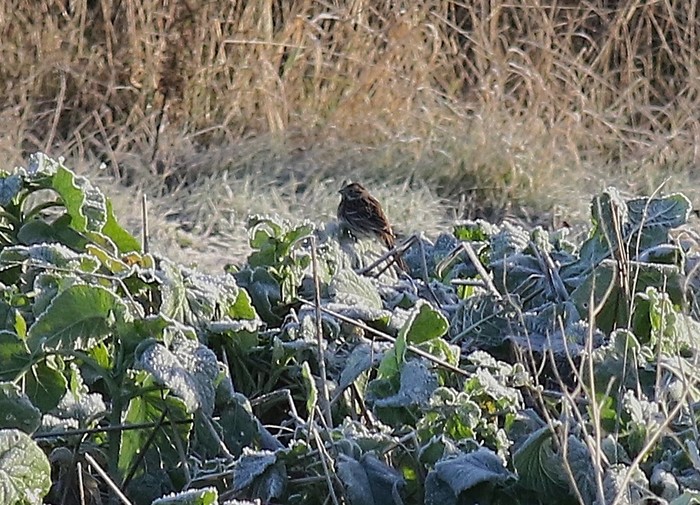
The final big discovery of the period (and the second good bird of 2017) was a female Black-throated Thrush seen briefly with Redwings at Whittle Dene Reservoirs, Northumberland on 2nd. Meanwhile, the female in St. Asaph, Denbighshire was still there to at least 31st although remaining highly elusive. Unfortunately there was no sign of it on New Year’s Day or subsequently. Continuing the thrush theme, the female Dusky Thrush made it into the New Year and was still around Beeley, Derbyshire to at least 3rd.
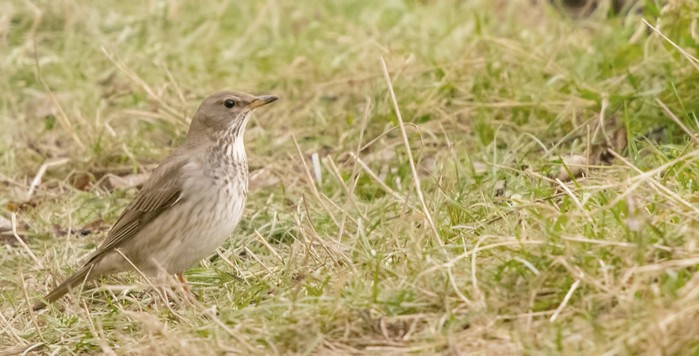
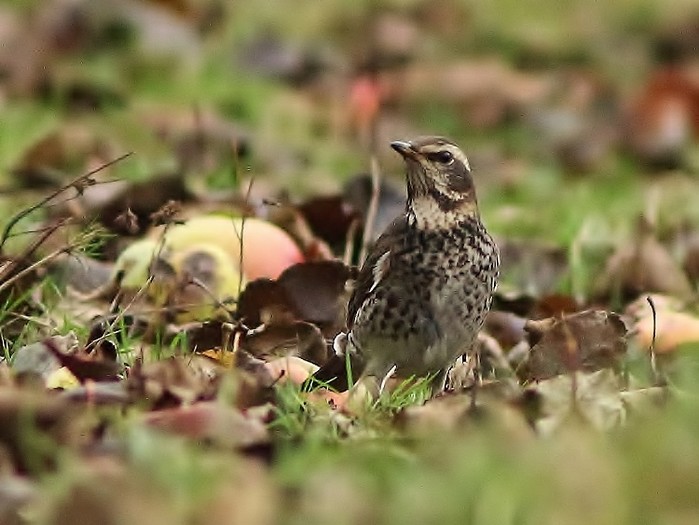
Still adding a dash of colour to the seasonal drabness were three male ‘Eastern Black Redstarts’ - at Torness, Lothian to 22nd and at Skinningrove, Cleveland and Mousehole, Cornwall to at least 3rd. Much less colourful, however, (and much more perplexing too) was the first-winter female apparent ‘Stejneger’s Stonechat’ at Dungeness, Kent, surprisingly revealed to be still present and then still in situ to at least 3rd.
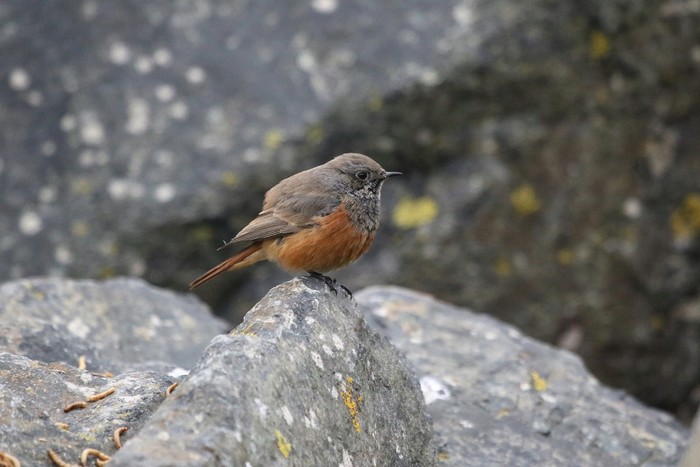
The recent news that this aberrant, grey-hued stonechat, first found back in November, had been identified from DNA evidence of a faecal sample as a stejnegeri Siberian Stonechat was certainly surprising. With photographs suggesting a rather restricted pale rump patch, dark feather centres in the uppertail coverts, some underlying dark in the throat and blurry grey lining in the flanks, most people’s money would certainly have been on the ‘aberrant European Stonechat’ option. To add further to the confusion, images soon appeared online of superficially similar aberrantly grey stonechats at Dartford, Kent in winter 2001/2, Rainham Marshes, London in November 2009 and in Richmond Park, London this very week (and present to at least 3rd). Presumably, though, all stonechat taxa can occasionally be aberrantly grey and in this plumage they would clearly resemble each other more closely.
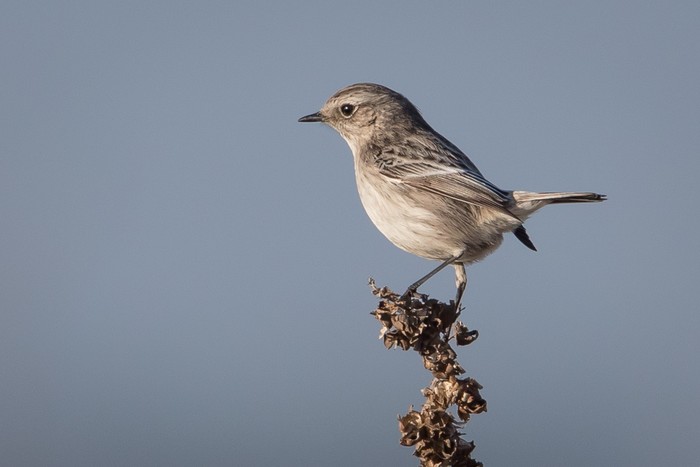
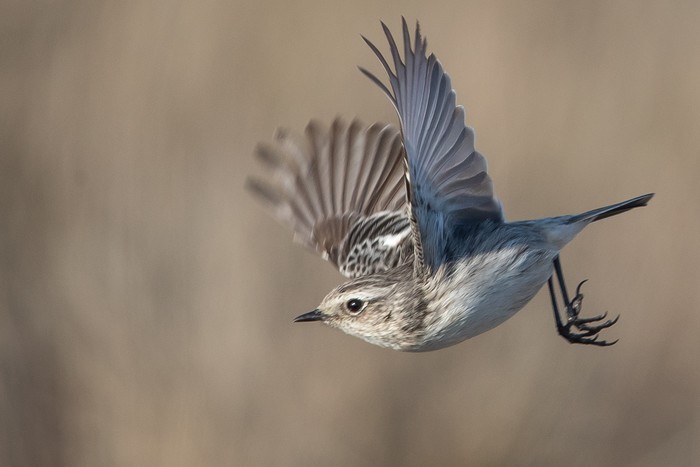
Back in the land of more identifiable birds, the Blyth’s Pipit was still at Blagdon Lake, Somerset to at least 30th but was not reported thereafter whilst the ‘Masked Wagtail’ at Camrose, Pembrokeshire seems also to have abandoned its winter territory and was not seen after Boxing Day.
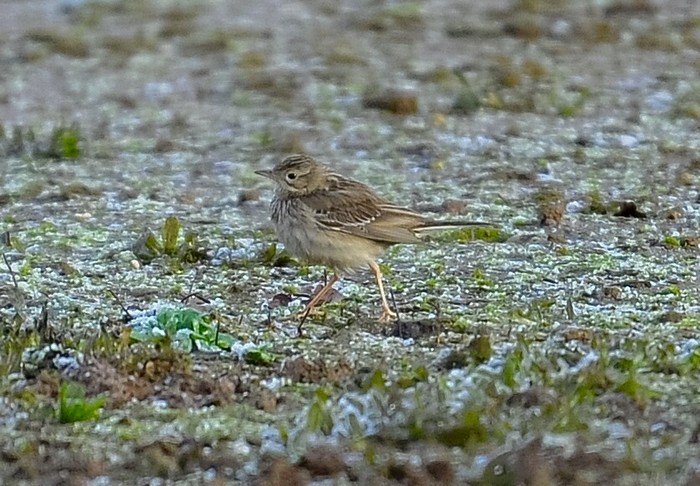
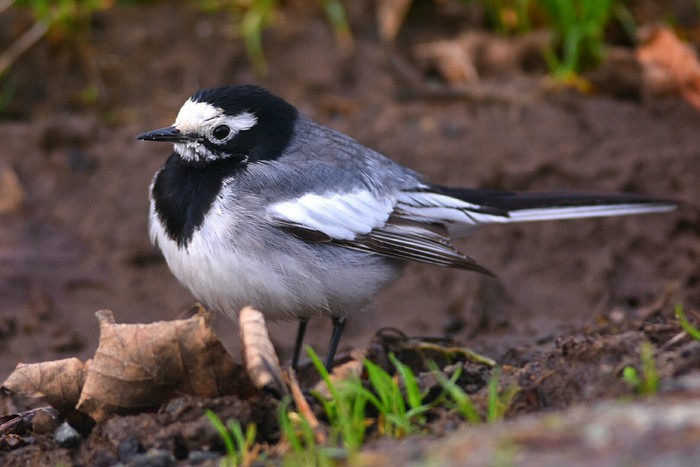
Turning to non-passerines, the Killdeer was still at Sandwick, Mainland Shetland to 3rd, presumably not enjoying the full force of Storms ‘Barbara’ and ‘Conor’. Also braving the grim conditions in northern Scotland was the American Coot still on North Uist, Western Isles to at least 2nd and the adult male Northern Harrier still on North Ronaldsay, Orkney to 31st. In Ireland, the Snowy Owl was seen again at Spiddal, Galway on 26th and 27th and then it or another was further south, at Lahinch, Clare on 28th.
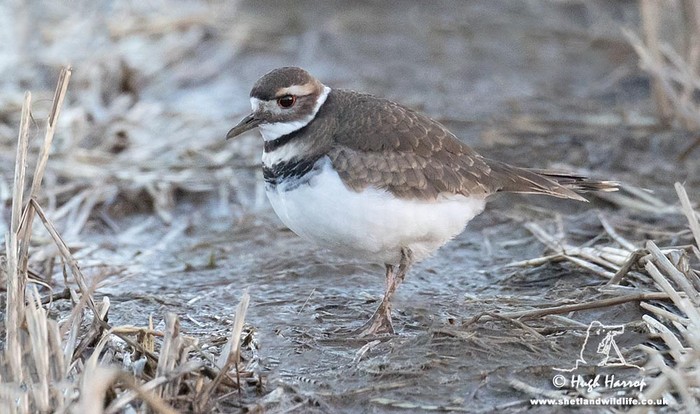
In England the lingerers included the juvenile Pallid Harrier at Welwick, Yorkshire to at least 3rd and, in Cornwall, the Pacific Diver still off Penzance to 3rd and the Hudsonian Whimbrel still at Perranuthnoe to at least 2nd.
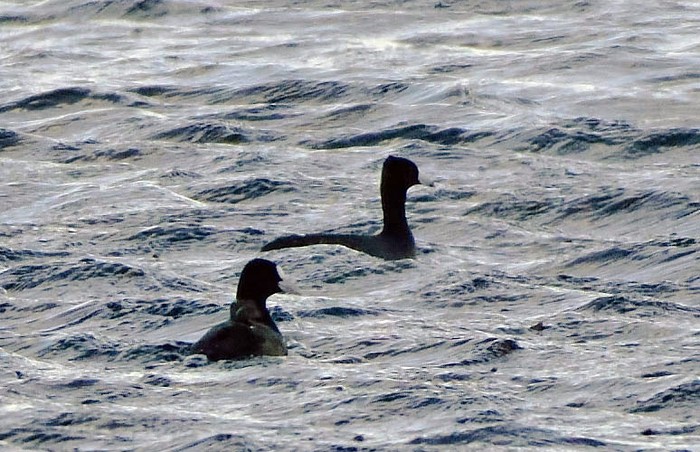
Further afield, the headline bird was 2017’s first Siberian Accentor in Finland (and the 240th in Europe since last October). Elsewhere a Killdeer and a Cattle Egret were in Norway (the latter only the country’s seventh ever), an adult Ivory Gull in Germany, a White-billed Diver in the Czech Republic, Franklin’s Gulls in Romania, Belgium and Denmark, a Pine Bunting in Belgium, a Black-throated Thrush in Finland, Hume’s Yellow-browed Warblers in Italy (two) and the Netherlands, an Oriental Turtle Dove on Cyprus, Citrine Wagtails in Morocco and Portugal, a Basalt Wheatear in Israel and a Common Yellowthroat and a Wood Duck on the Azores.
Despite the exceptionally windy conditions, scarce seabirds were very few. By far the most notable were five White-billed Divers still off Papa Westray, Orkney on 27th but Little Auks were at Lossiemouth, Moray on 25th, South Uist, Western Isles on 26th, 29th, 30th and 31st (four), Snab Point, Northumberland and Papa Westray, Orkney (two) on 27th and Skye, Highland on 2nd. A surge of sightings on 1st brought ten to Buckie and nine to Lossiemouth, both Moray, with three more at the latter location on 2nd. Finally, single Grey Phalaropes were on Islay Argyll on 25th and at Belvide Reservoir, Staffordshire on 27th.
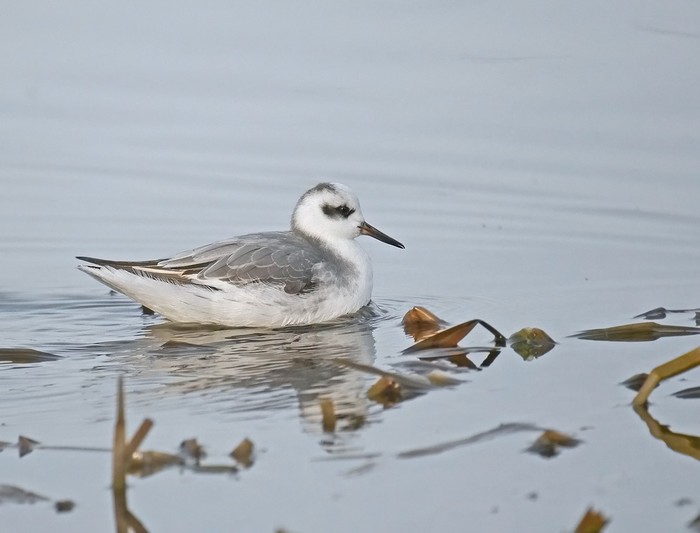
The selection of wildfowl across the Christmas and New Year period was a now familiar one. The Red-breasted Goose remained around Docking, Norfolk until 30th but was not seen thereafter, with the ‘Todd’s Canada Goose’ present in the same area until 29th but then missing over the New Year period too. In Ireland, two ‘Todd’s’ and a ‘Richardson’s Cackling Goose’ were still at Lissadell, Sligo and a ‘Todd’s’ at North Slob, Wexford. In Scotland a ‘Richardson’s Cackling Goose’ was still on Islay, Argyll. In Merseyside/Lancashire, the blue morph Snow Goose was still at Marshside/Martin Mere, with a white morph bird at Loch Ashie, Highland on 30th. Completing the goose line-up, ‘Black Brants’ were at Salthouse, Norfolk, Kilnsea, Yorkshire, Ferrybridge, Dorset and Levington Creek, Suffolk.
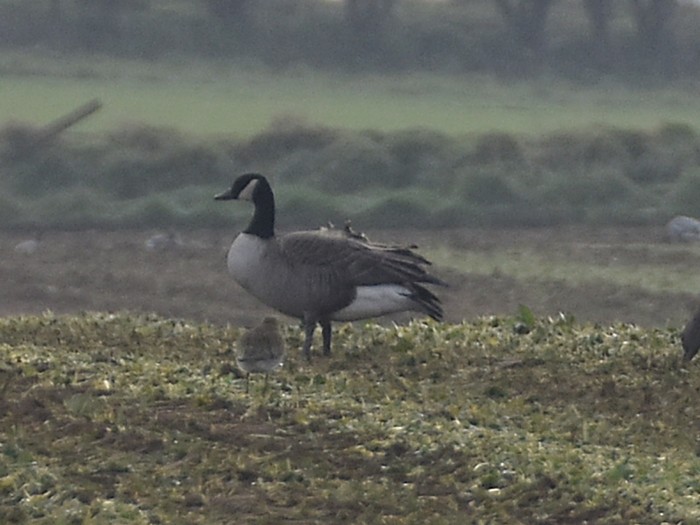
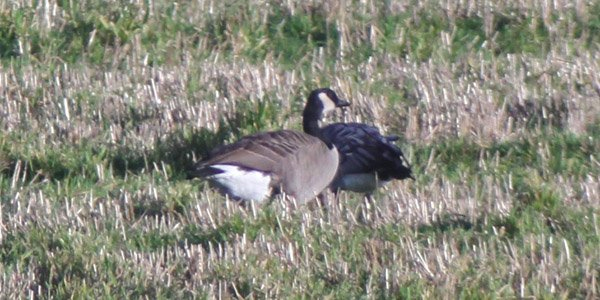
Headlining the ducks once more was the drake Hooded Merganser at Lochwinnoch, Clyde to at least 3rd. Green-winged Teal was the most common Nearctic duck species with seventeen noted - six in Ireland, seven in Scotland and four in England.
American Wigeons , by contrast, totalled just eight - at Oldbury-on-Severn, Gloucestershire, Caerlaverock, Dumfries and Galloway, Loch of Lintrathen, Angus, Tain and Clachnaharry, both Highland, Kingsmill Lake, Cornwall and Ernesettle and Countess Wear, both Devon.
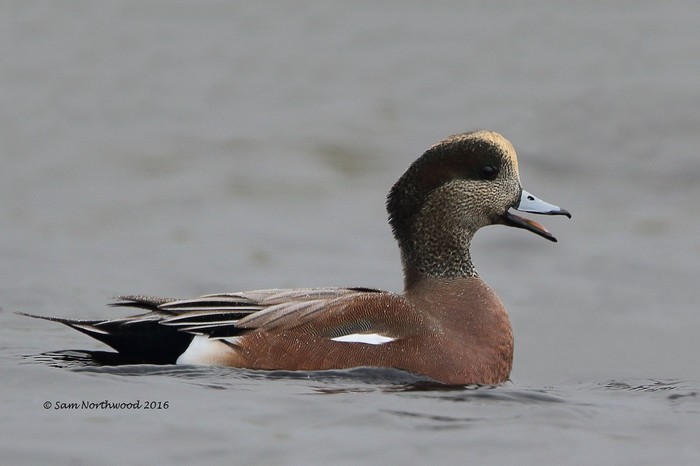
Turning to diving ducks, the best were Lesser Scaups at Loch Ryan, Stranraer, Loughrea, Galway, Lough Gara, Sligo and Siblyback Lake and Dozmary Pool, both Cornwall. Ring-necked Ducks put on a good showing with sixteen reported - nine in Ireland, two in Scotland, four in England and one in Wales.
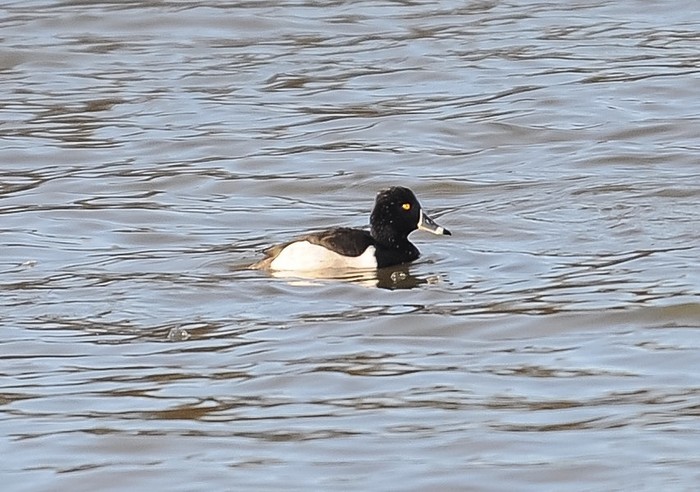
Finally, Ferruginous Ducks were reported again at Titchwell, Norfolk on 22nd and nearby Holme on 2nd and 3rd and at Washington, Durham on 29th.
At sea, the drake King Eider remained in the Ballysadare Bay/Mullaghmore, Sligo area to at least 1st whilst Surf Scoters were at Tentsmuir, Fife, Man Sands, Devon, Brandon Bay, Kerry (three), Murvagh, Donegal, Musselburgh, Joppa and Eastfield, all Lothian, and between Colwyn Bay and Llandulas, Conwy (two). By far the best record, however, was Leicestershire’s first - a juvenile at Rutland Water - on 27th to 3rd.
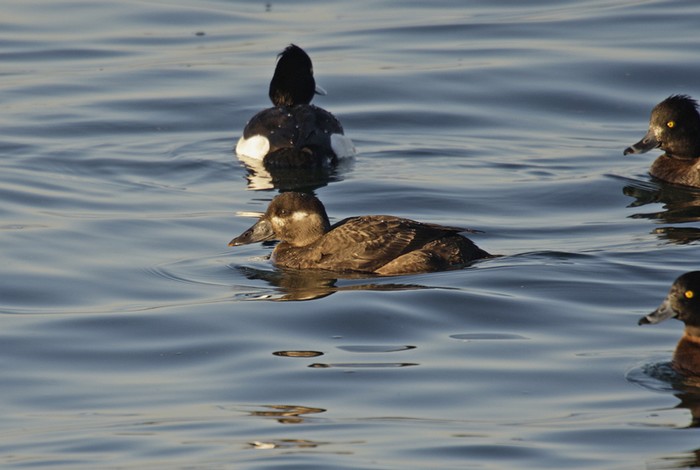
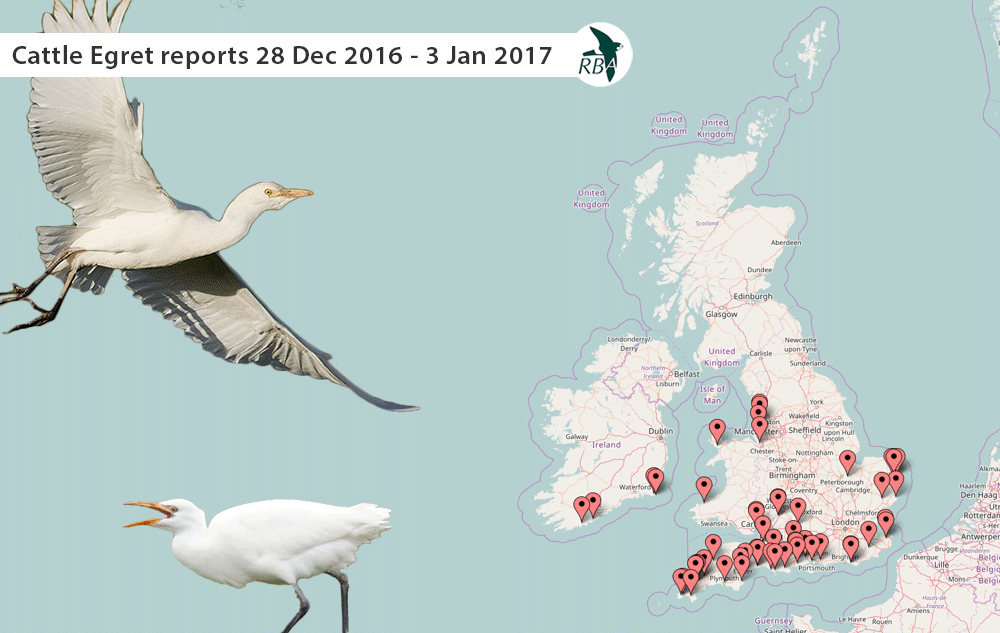
The Cattle Egret invasion continued unabated with well over a hundred now at large in Britain, mainly in Southwest England. Remarkably, therefore, three egret species are now present in Britain in three-figure numbers. Cattle Egret flocks included a new record for this winter of eighteen at Newquay, Cornwall but other groups included twelve at Frampton, Gloucestershire, eight at Warblington, Hampshire and Tomhaggard, Wexford, six at Drift Reservoir, Cornwall and Teigngrace, Devon, five at Malltraeth, Anglesey, four at Halvergate, Norfolk and three at Southport, Lancashire, Marston, Wiltshire, Bude and Sancreed, both Cornwall, Tacumshin, Wexford and Nottington, Dorset.
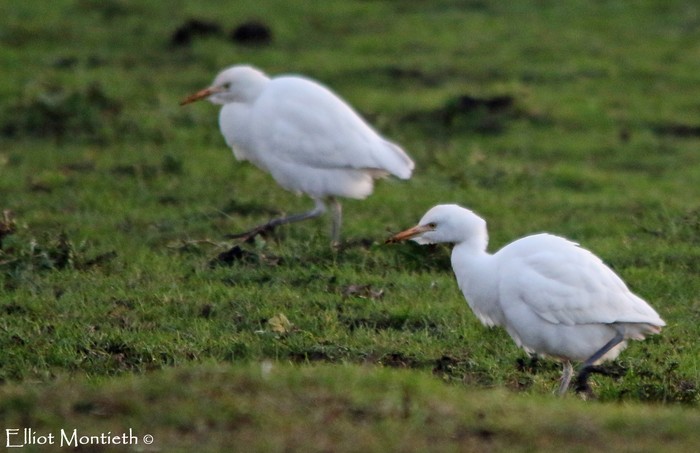
Glossy Ibises lingered at Cossington Meadows, Leicestershire, West Mersea/Vange Marsh, Essex, Stoke Newington, London, Ham Wall, Somerset (two) and Fremington, Devon.
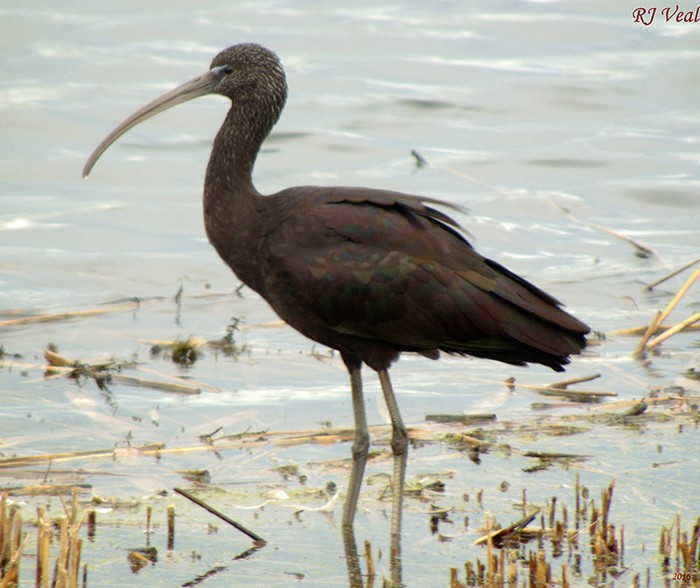
A Rough-legged Buzzard was reported over Duthil, Highland on 3rd.
The winter’s two rare waders - the Lesser Yellowlegs in Poole Harbour, Dorset and the Long-billed Dowitcher at Tacumshin, Wexford - both remained in place over the holiday period. Much less expected, however, was an unseasonal Temminck’s Stint at Branston Gravel Pits, Staffordshire on 2nd and 3rd.
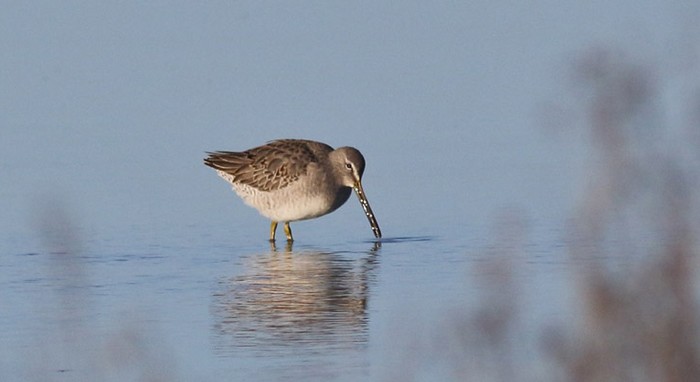
The rarest gull of the period was once again the adult Bonaparte’s Gull in Devon, seen again intermittently in the Teignmouth and Dawlish area.
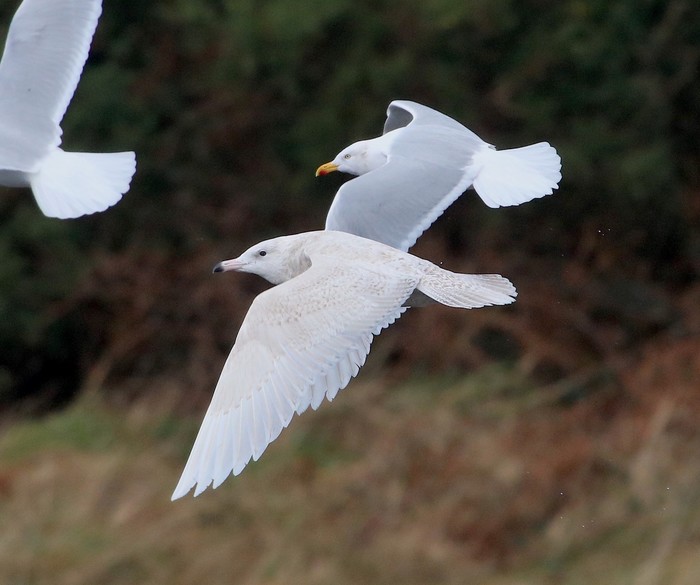
Perhaps a consequence of the stormy weather, Glaucous Gulls were suddenly much more prominent in the run up to the New Year. Over seventy were noted, mostly in the north and west but singles reached as far south as Beddington, London and Dungeness, Kent.
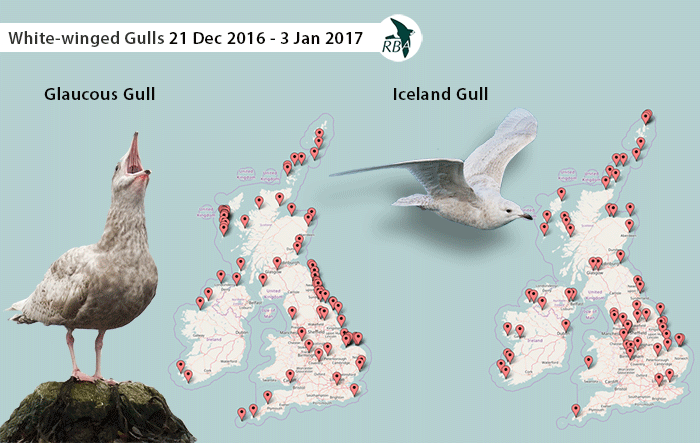
Iceland Gulls were more prominent too, numbering at least sixty, again mostly in the north and west but birds were also noted as far south as Cambridgeshire, Norfolk and Essex. The only ‘Kumlien’s Gulls’ were second-winters at Tralee, Kerry still to at least 26th and at Whitehouse Lagoon, Antrim on 30th and a juvenile on Barra, Western Isles on 1st.
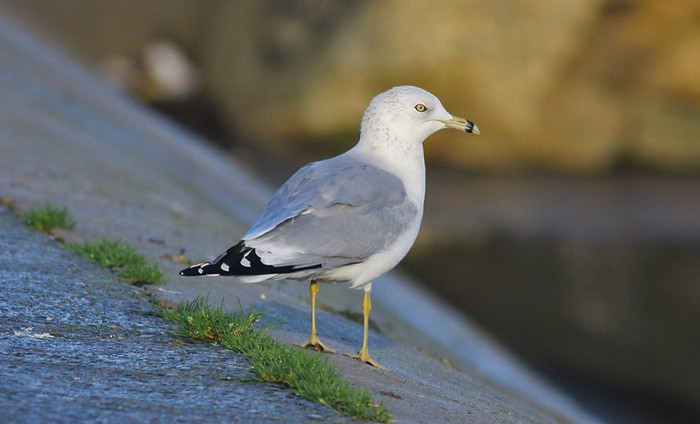
The main gull news of the week, however, was an apparent influx of Ring-billed Gulls , very scarce in recent months but now suddenly reported widely across Ireland - an adult at Tralee, Kerry to 3rd with first and second-winters there on 22nd and the first-winter still on 29th, a first-winter at Red Strand, Cork on 21st, a second-winter at Enniskillen, Fermanagh on 23rd to 3rd and adults at Cobh, Cork on 25th and 27th, Clancy Strand, Limerick on 25th, Nimmo’s Pier, Galway (two) on 27th, Bray, Wicklow on 27th to 2nd, Castletown Bearhaven, Cork on 28th, Timoleague, also Cork, and Carrahane, Kerry on 29th, Quilty, Clare on 30th, Carrickfergus, Antrim on 31st to 3rd, Wexford Harbour, Wexford on 1st to 3rd, Sandymount, Dublin on 2nd and Blennerville, Kerry on 3rd. In England, three first-winters were seen in Cornwall - at the Hayle Estuary on 24th, Marazion on 24th to 2nd and the Gannel Estuary on 1st. Elsewhere, up to two adults were still frequenting Blashford Lakes, Hampshire to at least 3rd. Other adults were at Wells, Norfolk on 29th and, in Wales, at Llys-y-fran Reservoir, Pembrokeshire on 29th, 30th and 2nd. Just one was noted in Scotland - at Strathclyde Loch, Clyde on 29th to 3rd.
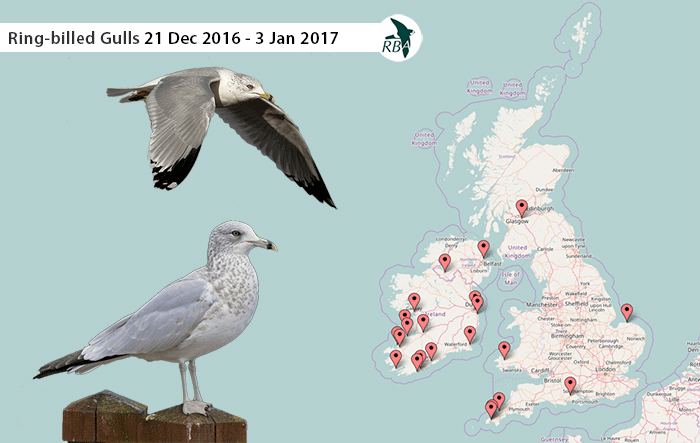
Back in Ireland, the Forster’s Tern was at Barna Pier, Galway on 22nd.
A final taste of autumn was provided by Pallas’s Warblers at a couple of typical migrant venues - The Naze, Essex on 22nd to 24th and Dursey Island, Cork on 30th - but otherwise it was mainly a case of lingering birds. Top of the pile were the male Desert Wheatear still at Thurlestone, Devon to at least 3rd, a Little Bunting still at Polgigga, Cornwall on 31st (with two there on 3rd) and a Dusky Warbler at Coombe Hill Meadows, Gloucestershire to 22nd. Also in Gloucestershire, a Richard’s Pipit was still at Arlingham Warth to at least 3rd with the two also still at Abbotsbury, Dorset to at least 3rd also. In Sussex, the Rose-coloured Starling remained at Crawley to at least 2nd with another at Dorchester, Dorset on 28th to 3rd (though apparently present there for some weeks already). A Serin was at Newhaven, Sussex on 24th to 29th.
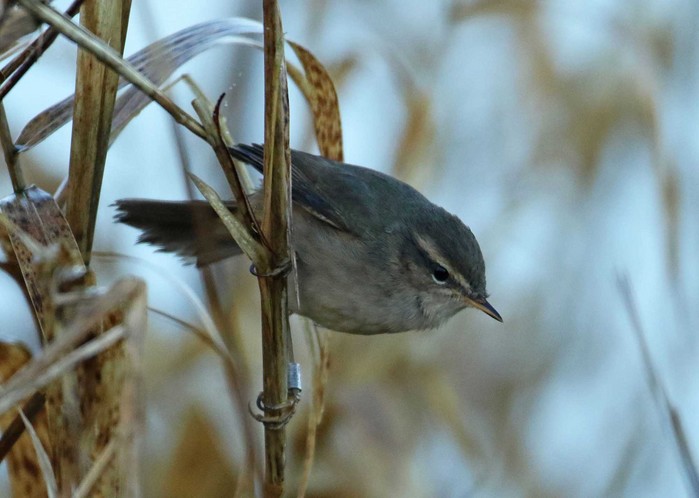
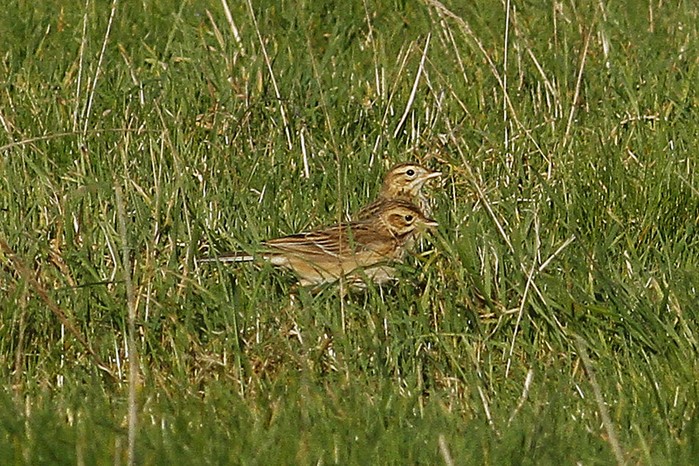
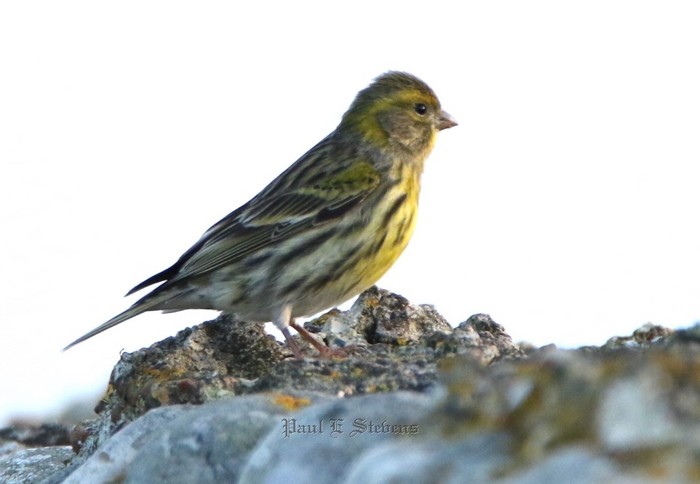
Over twenty Yellow-browed Warblers were logged over the holiday period, almost all in the Southwest where two were in Plymouth and Helston, both Cornwall, and two on St. Mary’s, Isles of Scilly. Away from Southwest England, singles were at Llanharan, Glamorgan on 27th, Cardiff, also Glamorgan, on 28th, Kinver, Staffordshire to at least 3rd, Wanstead Flats London to at least 1st, Dungarvan, Waterford on 1st, Llyn Penrhyn, Anglesey on 2nd and, at more typical autumn venues, at Flamborough Head, Yorkshire on 22nd, Dursey Island, Cork on 29th (the day before the Pallas’s Warbler!) and Soldier’s Point, Anglesey on 31st to 2nd.
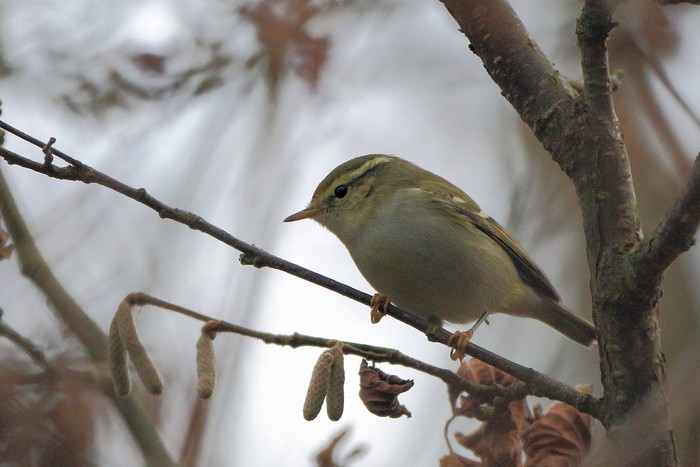
The period’s largest Shorelark flocks were twenty at Tyninghame, Lothian and thirty at Holkham, Norfolk whilst territory-holding Great Grey Shrikes numbered at least twenty-five, almost all in England but one was still at Doune, Forth and others were even further north at Forest of Birse, Aberdeenshire and Ashie Moor, Highland.
Waxwings remained concentrated in Scotland and the north but there was a noticeable southward shift in their distribution in northern England. The largest counts in Scotland were 300 in Edinburgh, 150 in Leith and 200 in Musselburgh, all Lothian, 642 around Glasgow, Clyde, 250 in Dundee, Angus, 200 in Nethy Bridge, Highland, 600 in Aberdeen, Aberdeenshire, 180 in Dunblane, Forth, 100 in Invergowrie, Perth and Kinross and 100 in Kirkcudbright, Dumfries and Galloway.
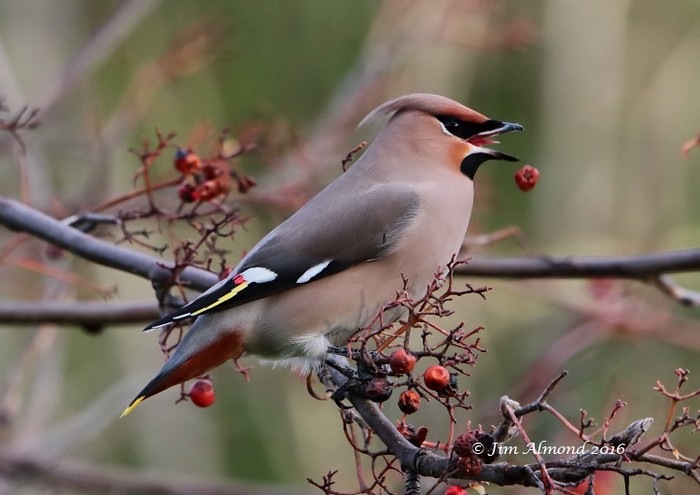
South of the border, 350 were in Thornaby-on-Tees, 220 in Middlesborough and 195 in Norton, all Cleveland, 130 in Newcastle, Northumberland, 100 in Durham and 112 in Blaydon, both Durham, 400 in Sheffield, 200 in Leeds, 108 in Hessle, 345 at Redmires Reservoir and 150 in Halifax, all Yorkshire, 106 in Barrow, Lancashire and 200 at Longshaw Estate, Derbyshire. A few more reached southern England with singles or small parties noted as far south as Gloucestershire, Oxfordshire, Bedfordshire, Essex, Hertfordshire, Kent, London and Devon.
Looking ahead, the New Year is starting off with a cool northwesterly airflow. Whilst the focus for many will be on the lingering rarities, many of which have made it into the New Year, we should really be thinking ahead to new opportunities. The obvious place to continue looking is all those sheltered, insect-harbouring corners inland, particularly in the west. After the astonishing late autumn of 2016 and the ongoing procession of discoveries in its wake, there must be more eastern passerines still to be found. And perhaps, given the influx of white-winged gulls over the Christmas and New Year period, it is time to start the hunt for the likes of Thayer’s, Glaucous-winged, Slaty-backed and Vega Gulls. Beyond that, we have a whole year of new possibilities ahead. 2017 will have to do well to top 2016 but whatever happens the new year is sure to be full of fabulous surprises and memorable encounters.
Andy Stoddart
4 January 2017
Share this story






